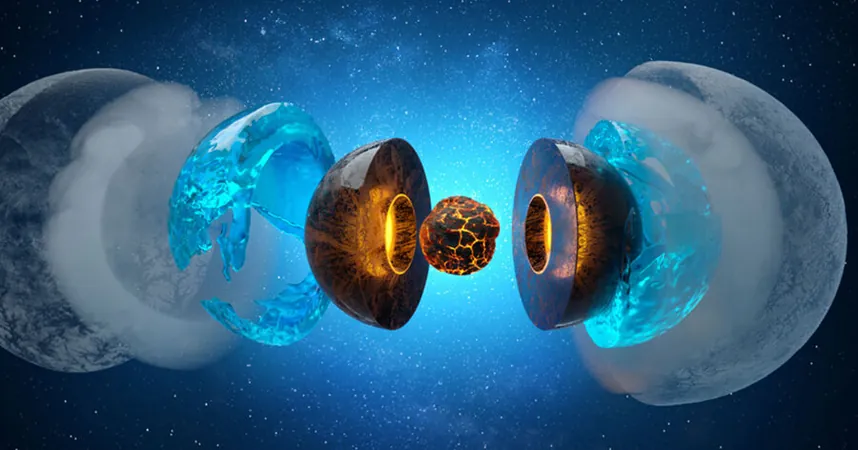
Hidden Oceans on Uranus and Neptune: A Groundbreaking Discovery!
2024-11-25
Author: Jessica Wong
Hidden Oceans on Uranus and Neptune: A Groundbreaking Discovery!
In an astonishing turn of events, scientists may have uncovered the mysteries lurking within the icy giants of our solar system, Uranus and Neptune. Recent research suggests that these two enigmatic planets could be home to vast oceans of water deep beneath their thick atmospheres.
Adam Masters, a notable space and planetary scientist from Imperial College London, expressed his excitement about this new hypothesis, stating, “We didn’t really know anything before about their interiors. So this hypothesis is very compelling.” The bold theory, proposed by Burkhard Militzer from the University of California, Berkeley, has been published in the prestigious Proceedings of the National Academy of Sciences, shedding light on the strange magnetic fields that define these planets.
Unlike Earth’s orderly magnetic field—which generates a clear dipole resembling a giant bar magnet—Uranus and Neptune exhibit chaotic magnetic properties. When NASA's Voyager 2 spacecraft made its historic flyby of Uranus in 1986, it detected a magnetic field that was significantly tilted and offset from the planet's center. Initially, scientists speculated that a massive impact early in Uranus's history could explain the disorder. Yet, when Voyager 2 later visited Neptune in 1989, similar anomalies were observed, leading to further investigations into the planets’ interiors.
To provide answers, Dr. Militzer conducted simulations involving the motion of 500 atoms and proposed that beneath their outer atmospheres lies a salty ocean of water, approximately 5,000 miles thick. This ocean, enriched with hydrogen and exhibiting extraordinary conductivity, plays a crucial role in generating the unique magnetic fields of both planets.
Interestingly, the conditions in these underwater realms are extreme; the pressure reaches an astonishing 60,000 times that of Earth’s surface, resulting in a state that behaves more like a supercritical fluid—a hybrid of gas and liquid—rather than conventional water. Moreover, there is a separation between this ocean and a denser carbon-rich layer below, which acts as a barrier between the ocean and the planetary cores. The core of Uranus alone is comparable in size to Mercury, while Neptune boasts a slightly larger core, akin to Mars.
The implications of this research are monumental, especially since it challenges previous understandings that the interiors of Uranus and Neptune were more homogenized. “The new thing is that the water separates from carbon,” Dr. Militzer highlighted. This crucial distinction indicates that ice giants formed with significantly less hydrogen than their gas giant counterparts—like Jupiter and Saturn—due to their greater distance from the sun.
Furthermore, these findings might explain the distinctive features that differentiate the gas giants from the ice giants. Fran Bagenal, a professor of astrophysics and a member of the Voyager science team, emphasized, “The first step to understanding our solar system is the difference between the gas giants and the terrestrial planets, and then the hydrogen planets and the ice giants.”
Excitingly, this research paves the way for potential future missions to Uranus, as NASA plans a return trip to the planet in the next decade. Such an expedition could employ advanced instruments to delve deeper into the interiors and magnetic fields, further confirming the presence of this mysterious water layer.
As Dr. Bagenal aptly put it, “It’s just another reason to go back.” Could this groundbreaking discovery unlock the secrets of our solar system and revolutionize our understanding of planetary formation? The cosmos is filled with wonders yet to be revealed!



 Brasil (PT)
Brasil (PT)
 Canada (EN)
Canada (EN)
 Chile (ES)
Chile (ES)
 España (ES)
España (ES)
 France (FR)
France (FR)
 Hong Kong (EN)
Hong Kong (EN)
 Italia (IT)
Italia (IT)
 日本 (JA)
日本 (JA)
 Magyarország (HU)
Magyarország (HU)
 Norge (NO)
Norge (NO)
 Polska (PL)
Polska (PL)
 Schweiz (DE)
Schweiz (DE)
 Singapore (EN)
Singapore (EN)
 Sverige (SV)
Sverige (SV)
 Suomi (FI)
Suomi (FI)
 Türkiye (TR)
Türkiye (TR)